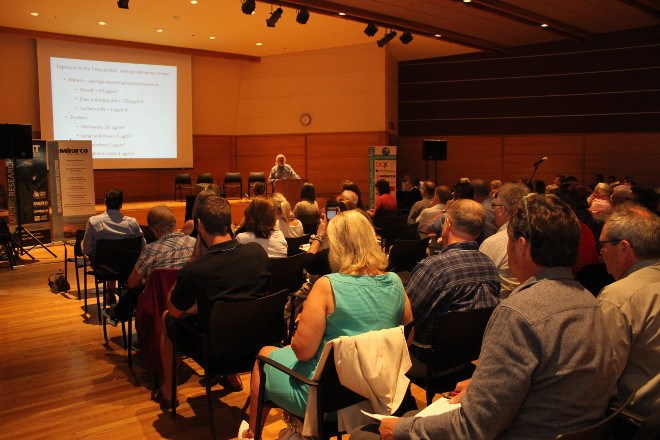Long-term exposure to diesel fumes are a leading cause of lung cancer in miners, that is not a surprise to many working in the industry, multiple studies have proven it.
The challenge now is how to protect miners from further exposure and ultimately replace the decades-old fuel with something safer? Those questions were being presented and discussed at the Lung Cancer and Prevention in Mining Symposium at the Willet Green Miller Centre auditorium on July 11. Hosted by the Occupational Cancer Research Centre and Mirarco Mining Innovation, more than 100 people, representing everyone from the Ontario Ministry of Labour, to mining companies, to researchers and workers' unions and individual miners were on hand to discuss the hazards of exposure to diesel fumes and other hazards like radon and discuss progress, the latest research and possible prevention and elimination.
Hosting this symposium in Sudbury was a natural fit, according to host Vic Pakalnis, president and CEO or Mirarco Mining Innovation and associate vice-president of Laurentian Mining, Innovation and Technology.
“Actually they (Occupational Cancer Research Centre) came to us (Mirarco) and asked if we could host this very unique symposium,” he said in an interview. “It seemed perfect, considering Sudbury is the heart of mining in the province. This is a serious issue and a costly one for the industry. We are framing it in ways that show the impact it has on everything from costs to the government, to human lives being lost.”
The day was a busy one with guest speakers presenting on everything from the costs to past struggles to have research papers published due to corporate and legal pushback. But the main topic was how diesel exposure has caused thousands of lung cancer cases among those working in the mines and the measures companies and the government have taken to lessen exposure. Among the guest speakers was Paul Demers, director of the Occupational Cancer Research Centre, who spoke about impact of exposure to cancer-causing agents in diesel exhaust and radon gas. While exposure has been lessened, lung cancer due to exposure is still a major hazard to miners.
Demers talked about a five-part hierarchy of controls: personal protection, administrative controls, engineering controls,substitution and complete removal of the hazard. Removing the hazard altogether is the ultimate goal, but Demers said that will mean a complete change in how mines are powered and air is filtered. “There was a time when mines were powered by electricity from non-diesel sources, but at the time diesel was considered more economical,” he said. “Now mines are looking at going back to electricity, it's a matter of how will they make it economical. Diesel engines are portable, electrical engines are not as portable or powerful right now.”
To make it more appealing, symposiums like this one show the long-term human costs of diesel exposure. Demers said each new lung cancer case caused by diesel exhaust exposure costs the provincial government around $790,000 a year. Most of those cases, he said, are preventable with the right application of safety measures.
“We've lowered the risks, but they can be lowered more,” he said. “These are human lives that are at stake, but we are framing this in terms of costs to show how it is an economic burden as well to get the attention of the government and companies. If we show how this is a financial burden it gets their attention faster. Many of these cases are not compensated. If we show how much it would cost if they were there will be more prevention.”




